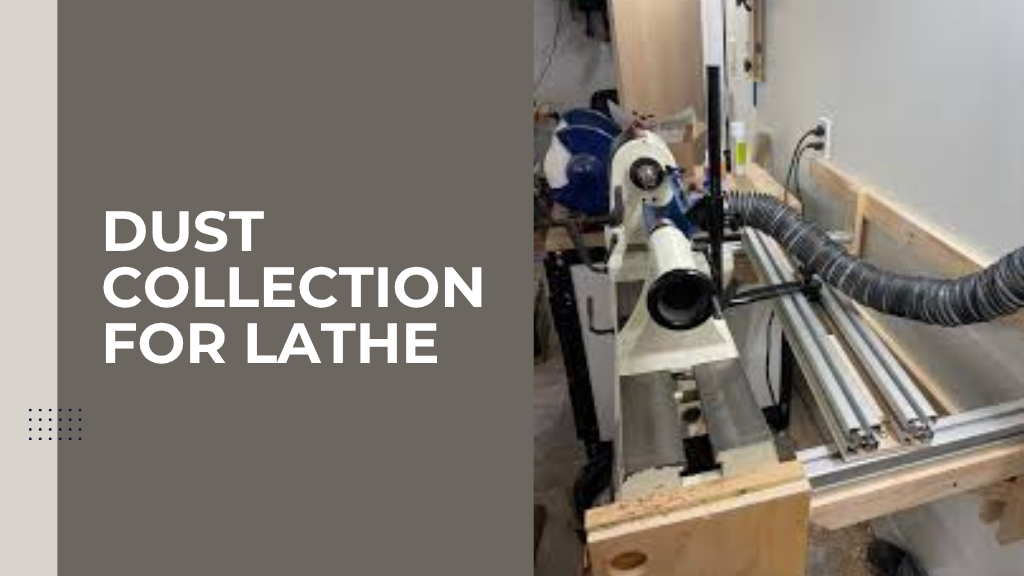Dust collection for lathe work is a critical aspect of any woodworking shop. For any woodworker, the satisfaction of creating something beautiful from a raw piece of timber is unmatched. However, this rewarding craft comes with a messy and potentially hazardous byproduct: wood dust. Specifically, when working on a lathe, fine particles and larger shavings are flung into the air, creating a cloud that can not only coat every surface in your workshop but, more importantly, pose significant health risks.
This comprehensive guide will walk you through everything you need to know about setting up effective dust collection for lathe work, ensuring a safer and cleaner environment for your passion. By understanding the dangers of wood dust and implementing the right system, you can protect your health and your tools, allowing you to enjoy your craft for many years to
Why is Lathe Dust Collection So Important?
Many woodworkers, especially those new to the craft, might view dust as a simple nuisance to be swept up later. The reality is far more serious. The dust generated from a wood lathe isn’t just a mess; it’s a health and safety hazard. Understanding these risks is the first step toward building a safer workshop.
Health Risks
Wood dust is classified as a human carcinogen by the International Agency for Research on Cancer (IARC). Prolonged exposure can lead to a host of respiratory issues, including:
- Asthma and Allergies: The fine particles can irritate the lungs and trigger allergic reactions or chronic respiratory conditions.
- Sinus and Nasal Cancer: Studies have linked long-term exposure to wood dust, particularly from hardwoods like oak and mahogany, to an increased risk of nasal and sinus cancers.
- Bronchitis and Other Lung Diseases: Inhaling fine dust can lead to inflammation of the bronchial tubes, resulting in chronic bronchitis and other irreversible lung diseases.
Safety Concerns
Beyond the health risks, a dusty workshop presents a number of practical dangers:
- Fire Hazard: A significant accumulation of fine wood dust on surfaces, in ductwork, or inside a dust collector itself can be highly combustible. A small spark from static electricity, a faulty motor, or a stray ember—can ignite this dust, leading to a flash fire or even an explosion.
- Reduced Visibility: A thick cloud of dust can obscure your vision, making it difficult to see what you’re doing. This increases the risk of accidents with sharp tools or the spinning workpiece on the lathe.
- Equipment Damage: Fine dust can work its way into the moving parts and electronics of your machinery, including the lathe’s motor. This can lead to premature wear, overheating, and eventual failure of your expensive equipment.
By investing in and properly setting up dust collection for lathe operations, you’re not just keeping your workspace clean; you’re protecting your health, your family, and your investment in your woodworking tools.
The Science Behind Lathe Dust: Fine Particles vs. Shavings
To effectively capture dust, it’s crucial to understand the two main types of debris a lathe produces:
-
Wood Shavings:
These are the larger, heavier pieces of wood that are thrown off the workpiece. They’re relatively easy to deal with, as gravity quickly pulls them to the ground. A simple shop vacuum or a basic dust collector with a large-diameter hose can handle these with no problem.
-
Fine Wood Dust:
This is the real enemy. These microscopic particles can remain airborne for hours, penetrating deep into your lungs. They are produced during sanding, scraping, and other finishing operations. Capturing these fine particles requires a more sophisticated and powerful dust collection system.
A great dust collection setup for a lathe must be capable of handling both of these types of waste effectively. Ignoring the fine dust is a common and dangerous mistake.
Choosing the Right Dust Collection for Lathe
The market offers a wide variety of dust collection systems, from simple shop vacuums to elaborate, whole-shop setups. The best choice for you will depend on your budget, the size of your workshop, and the types of projects you undertake.
1. Shop Vacuums
- Best for: Small workshops, hobbyists, and those on a tight budget.
- Pros: Inexpensive, portable, and versatile. Can be used for general workshop cleanup.
- Cons: Not designed for continuous use, have a small collection capacity, and their filters often clog quickly with fine dust. The suction power is often insufficient to capture all the airborne particles. For a small lathe, a shop vacuum can be a starting point, but it’s not a long-term solution for serious woodturning.
2. Single-Stage Dust Collectors
- Best for: Small to medium-sized workshops, woodworkers who are getting serious about dust control.
- Pros: More powerful than a shop vacuum, with a larger collection bag. They can handle both chips and a good amount of fine dust.
- Cons: The air passes directly through the fan impeller before hitting the filter. This means large chunks of wood can strike the impeller, potentially causing damage. The filter bag can also clog with fine dust, reducing suction power over time.
3. Two-Stage Dust Collectors (The Ideal Solution)
- Best for: Serious woodturners and professional workshops. This is the gold standard for dust collection for lathe work.
- Pros: In a two-stage system, a cyclone separator or a baffle is placed before the fan and filter. This “first stage” separates the heavy chips and shavings from the airflow, dropping them into a collection barrel. The “second stage” consists of the fan and a fine-particle filter (typically a canister filter). This design has several key advantages:
-
- Maintains Suction: The filter doesn’t clog as quickly, ensuring consistent and powerful suction.
- Protects the Impeller: The fan is protected from damage by larger pieces of wood.
- Easier Waste Disposal: The heavy chips are collected in a separate barrel, making disposal simple and efficient.
- Superior Air Filtration: Canister filters on two-stage systems typically have a much smaller micron rating, meaning they can trap a higher percentage of the dangerous fine dust. A good two-stage system with a high-quality filter can capture particles as small as 0.5 microns.
Designing and Setting Up Your Lathe Dust Collection System
Having the right equipment is only half the battle. A poorly designed setup can render even the most powerful dust collector ineffective. Here’s a step-by-step guide to setting up your system for maximum efficiency.
1. The Collection Hood: The Heart of the System
This is arguably the most critical component. The collection hood is the part of the system that physically captures the dust and chips as they leave the lathe.
- Positioning is Key: The hood must be positioned as close to the source of the dust as possible. For woodturning, this means placing it behind the workpiece, directly in the path of the flying debris. A common mistake is to place it too far away, where its effectiveness drops dramatically.
- DIY vs. Commercial: You can purchase commercially available dust hoods, or you can build your own. Many woodturners have had great success building custom hoods from plywood or MDF, designed to fit their specific lathe and working style. The key is to create a wide opening that funnels the dust directly into the hose.
2. The Hose and Ductwork
The path the dust travels from the hood to the collector is just as important as the collection device itself.
- Diameter: Use the largest diameter hose possible. For most lathes, a 4-inch or 6-inch diameter hose is recommended. The larger the diameter, the less friction there is, and the more airflow your system will have.
- Length: Keep the hose as short and straight as possible. Every bend, elbow, and foot of hose reduces the overall airflow and static pressure of the system.
- Material: Opt for a smooth-walled hose or PVC ductwork whenever possible. The ridges inside a flexible hose create turbulence, which reduces airflow.
3. Air Filtration and Ambient Air Cleaners
Even with a perfect collection setup, some fine dust will inevitably escape into the air. This is where an ambient air cleaner becomes a vital part of a complete dust collection strategy.
- What it does: An ambient air cleaner is a ceiling-mounted box with a powerful fan and a series of filters. It continuously pulls air from the workshop, filters out the fine dust, and returns clean air.
- Placement: For maximum effectiveness, place the air cleaner in a central location, or in a position that creates a circular airflow pattern in your workshop. This ensures that all the air in the room is filtered over time.
Expert Tips for Optimizing Your Setup
Drawing from years of experience in woodworking, here are some actionable tips to take your dust collection for lathe work to the next level:
-
Use a Thien Baffle or a Cyclone Separator:
If you have a single-stage dust collector, consider adding a Thien baffle or a small cyclone separator. These inexpensive additions can convert a basic system into a much more efficient two-stage one. They effectively separate the heavy chips, protecting your impeller and extending the life of your filter. This is a game-changer for many woodturners.
-
Build a Dedicated Lathe Dust Hood:
Don’t rely on a generic dust hood. Build a custom one that fits your specific lathe and the way you work. Design it with a wide, flared opening to capture the dust thrown from the spinning workpiece.
-
Check for Leaks:
Periodically inspect all your hoses, fittings, and the dust collector itself for any leaks. Even a small leak can significantly reduce the efficiency of your system. Use duct tape or clamps to seal any gaps.
-
Clean Your Filters Regularly:
A dirty filter is an ineffective filter. Regularly cleaning the filters on your dust collector and ambient air cleaner will ensure maximum suction and air quality. For canister filters, a simple shaking mechanism or a brush can help dislodge the dust. For bag filters, a thorough shaking and occasional washing (if the manufacturer allows) is necessary.
-
Wear a Respirator:
Even with the best dust collection system, it’s impossible to capture 100% of the airborne dust. A high-quality N95 or N100 respirator should be considered the last line of defense, especially during sanding operations. It’s a small investment that offers a significant layer of protection for your lungs.
Conclusion:
When it comes to woodworking, the greatest investment you can make isn’t in a new tool or a fancy piece of lumber; it’s in your health and safety. Setting up an effective dust collection for lathe work is a critical step in creating a safe and enjoyable environment. By choosing the right system, designing a smart layout, and consistently maintaining your equipment, you can dramatically reduce your exposure to harmful wood dust.
Whether you’re a weekend hobbyist or a full-time professional, taking these steps will ensure that you can continue to enjoy your craft for many years to come. A clean workshop isn’t just a point of pride, it’s a necessity.
FAQs
Q: Can I use a simple shop vacuum for my lathe?
A shop vacuum is only suitable for very light, occasional use on a lathe. They lack the power and capacity for a proper job. Their filters clog quickly, and they often can’t capture fine, hazardous dust. For any serious turning, a dedicated dust collector is a much better investment.
Q: What is a micron rating, and why is it important?
A micron rating shows what particle size a filter can catch. A lower rating means smaller particles are trapped. For fine dust, you need a filter of 1 micron or less; a 0.5-micron filter is best for capturing the most harmful dust.
Q: How do I deal with static electricity in my ductwork?
Static electricity can build up in plastic hoses, posing a fire risk with fine dust. To prevent sparks, use static-conductive ducting. A more affordable option is to run a bare copper wire inside the hose, grounding it to the dust collector or an outlet.
Q: Should I vent my dust collector outside?
Venting a dust collector outside removes fine dust but wastes conditioned air, raising energy costs. It also creates negative pressure, pulling in unfiltered outside air. A sealed, recirculating system is often a better solution. Local building codes should always be checked.




